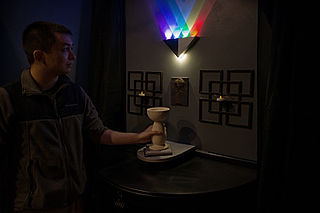
A doll is a model typically of a human or humanoid character, often used as a toy for children. Dolls have also been used in traditional religious rituals throughout the world. Traditional dolls made of materials such as clay and wood are found in the Americas, Asia, Africa and Europe. The earliest documented dolls go back to the ancient civilizations of Egypt, Greece, and Rome. They have been made as crude, rudimentary playthings as well as elaborate art. Modern doll manufacturing has its roots in Germany, from the 15th century. With industrialization and new materials such as porcelain and plastic, dolls were increasingly mass-produced. During the 20th century, dolls became increasingly popular as collectibles.

A browser game is a video game that is played via the internet using a web browser. They are mostly free-to-play and can be single-player or multiplayer. Alternative names for the browser game genre reference their software platform used, with common examples being Flash games, and HTML5 games.

Pixel art is a form of digital art drawn with graphical software where images are built using pixels as the only building block. It is widely associated with the low-resolution graphics from 8-bit and 16-bit era computers, arcade machines and video game consoles, in addition to other limited systems such as LED displays and graphing calculators, which have a limited number of pixels and colors available. The art form is still employed to this day by pixel artists and game studios, even though the technological limitations have since been surpassed.

Habbo is an online virtual world. It is owned and operated by Sulake. Habbo's main audience are teenagers and young adults. Founded in 2000, Habbo has expanded to nine online communities, with users from more than 150 countries. Since August 2012, more than 273 million avatars have been registered with an average of 500,000 visitors per month.

In computing, an avatar is a graphical representation of a user, the user's character, or persona. Avatars can be two-dimensional icons in Internet forums and other online communities, where they are also known as profile pictures, userpics, or formerly picons. Alternatively, an avatar can take the form of a three-dimensional model, as used in online worlds and video games, or an imaginary character with no graphical appearance, as in text-based games or worlds such as MUDs.

The Palace is a computer program to access graphical chat room servers, called palaces, in which users may interact with one another using graphical avatars overlaid on a graphical backdrop. The software concept was originally created by Jim Bumgardner and produced by Time Warner in 1994, and was first opened to the public in November 1995.

Fashion dolls are dolls primarily designed to be dressed to reflect fashion trends. They are manufactured both as toys for children to play with and as collectibles for adults. The dolls are usually modeled after teen girls or adult women, though child, male, and even some non-human variants exist. Contemporary fashion dolls are typically made of vinyl or another plastic.

Paper dolls are figures cut out of paper or thin card, with separate clothes, also made of paper, that are usually held onto the dolls by paper folding tabs. They may be a figure of a person, animal or inanimate object. Paper dolls have been inexpensive children's toys for almost two hundred years. Today, many artists are turning paper dolls into an art form.

In role-playing video games, a paper doll is a way of representing a player character's inventory and currently used equipment. In games that use a paper doll inventory management system, the sprites or 3D models of equipment, such as clothing or armour, can be placed on top of an image of the player character. This is similar to how the paper cut-outs of real-world paper dolls are used.

An escape room video game, also known as escape the room, room escape, or escape game, is a subgenre of point-and-click adventure game which requires a player to escape from imprisonment by exploiting their surroundings. The room usually consists of a locked door, objects to manipulate, and hidden clues or secret compartments. The player must use the objects to interact with other items in the room to reveal a way to escape. Escape the room games were born out of freeware browser games created in Adobe Flash, but have since become most popular as mobile games for iOS and Android. Some examples include Crimson Room, Viridian Room, MOTAS, and Droom. The popularity of these online games has led to the development of real-life escape rooms all around the world.
Diva Starz was a series of talking fashion dolls created and released by Mattel in October 2000. They are similar in design to MGA's Bratz and Tiger Electronics' Furby. Alexa, Nikki, Summer—later replaced by Miranda—and Tia were offered in the original debut. Originally produced as robotic dolls, Mattel would also release miniature and fashion doll versions in response to their initial success. The line was discontinued in 2004.

Whirled is a virtual world website and video game created by Three Rings Design. Its Open Beta stage was announced at the Game Developers Conference in 2007. It makes use of Adobe Flash as an applet embedded into the website while also having pages of HTML and JavaScript in a sidebar to allow players to manage their friends list and browse various categories of user-generated content. The concept is comparable to the virtual worlds in the PlayStation 3 game Home and Second Life, while also incorporating aspects of feed-based social media sites like Facebook and Twitter. It pushes to make all content user-created, mainly with its approach to creative accessibility using Flash's affinity for 2D vector graphics and various web compatibilities to make it very simple for players to upload a wide variety of content using simple, conventional file formats. Some examples of this include uploading PNG files to create in-game objects, and MP3 files to create a music playlist for a player's room.
WeeWorld was a Scottish social networking and messaging website, originally created in 2000 by a company based in Glasgow, Scotland, with smaller offices in London and Boston, Massachusetts. The company created WeeWorld.com, which hosted a massively multiplayer online game aimed at teens and preteens. The game was known for its brand of virtual world-based social simulation and customizable avatars known as "WeeMee's". The game was also released on a variety of digital platforms and services. By the time of its dissolution, there were an estimated 180 million WeeMees created worldwide.

Stardoll is a browser-based game from Glorious Games. One of the world's largest online fashion communities, Stardoll has reached over 400 million users as of January 2016.
World Golf Tour is an online multiplayer virtual golf game. It is played virtually on actual golf courses located in the United States, the United Kingdom, the Netherlands, Canada and Mexico, using a patented 3D photorealistic georeferencing technology. Players can play with their family or friends, join a foursome, or start their own game. Players can choose and compete in a variety of virtual golf courses with up to four players at a time, play individually or enter into a skills challenge or in tournaments for prizes.

Girls' toys and games are toys and games specifically targeted at girls by the toy industry. They may be traditionally associated either exclusively or primarily with girls by adults and used by girls as an expression of identity. One commentator have argued that the market for girl's toys and games is more challenging than that for boys' toys and games.

Bin Weevils was a British MMORPG involving a virtual world containing a range of online games and activities.
Ninja Kiwi, previously known as Kaiparasoft Ltd, is a mobile and online video game developer founded in Auckland, New Zealand, in 2006 by brothers Chris and Stephen Harris. Ninja Kiwi's first game was a browser based game called Cash Sprint, developed on the Adobe Flash Platform. Since then, they have produced more than 60 games across platforms including Adobe Flash, Android, iOS, PlayStation Portable, Nintendo DS, and more recently, Steam. Their most well-known titles are the Bloons and Bloons Tower Defense games. In 2012, Ninja Kiwi purchased Digital Goldfish, a Dundee, Scotland-based developer, for an undisclosed sum.

Digital Fashion is the visual representation of clothing built using computer technologies and 3D software. This industry is on the rise due to ethical awareness and uses of digital fashion technology such as artificial intelligence to create products with complex social and technical software.
Stage3D is an Adobe Flash Player API for rendering interactive 3D graphics with GPU-acceleration, within Flash games and applications. Flash Player or AIR applications written in ActionScript 3 may use Stage3D to render 3D graphics, and such applications run natively on Windows, Mac OS X, Linux, Apple iOS and Google Android. Stage3D is similar in purpose and design to WebGL.















